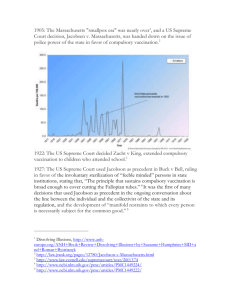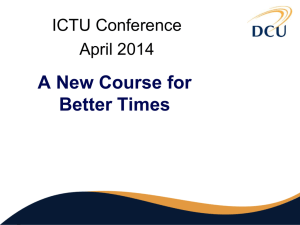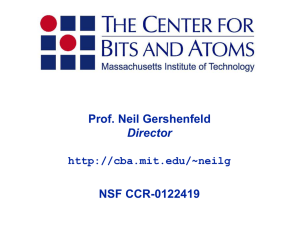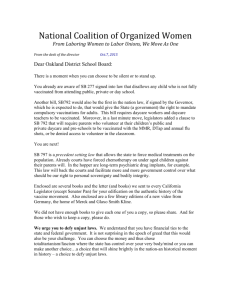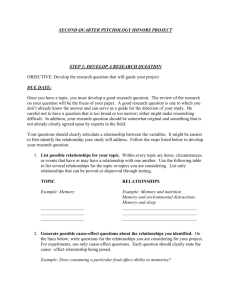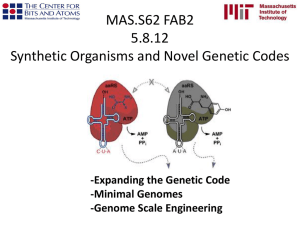at 100 Years
advertisement
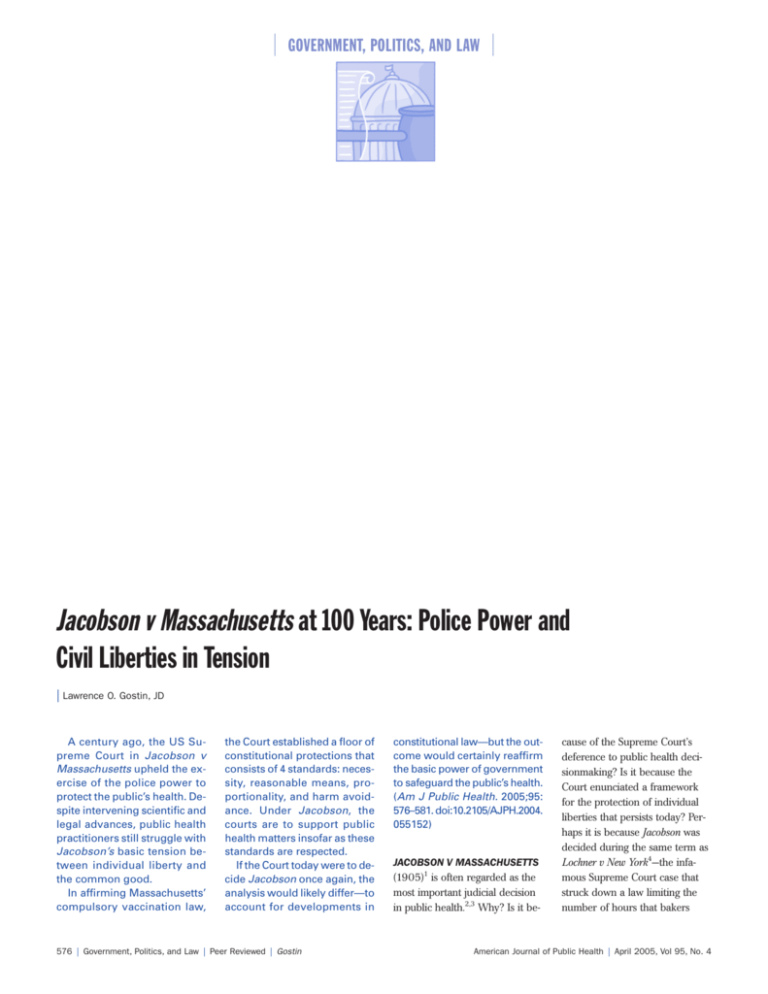
GOVERNMENT, POLITICS, AND LAW Jacobson v Massachusetts at 100 Years: Police Power and Civil Liberties in Tension | Lawrence O. Gostin, JD A century ago, the US Supreme Court in Jacobson v Massachusetts upheld the exercise of the police power to protect the public’s health. Despite intervening scientific and legal advances, public health practitioners still struggle with Jacobson’s basic tension between individual liberty and the common good. In affirming Massachusetts’ compulsory vaccination law, the Court established a floor of constitutional protections that consists of 4 standards: necessity, reasonable means, proportionality, and harm avoidance. Under Jacobson, the courts are to support public health matters insofar as these standards are respected. If the Court today were to decide Jacobson once again, the analysis would likely differ—to account for developments in 576 | Government, Politics, and Law | Peer Reviewed | Gostin constitutional law—but the outcome would certainly reaffirm the basic power of government to safeguard the public’s health. (Am J Public Health. 2005;95: 576–581. doi:10.2105/AJPH.2004. 055152) JACOBSON V MASSACHUSETTS (1905)1 is often regarded as the most important judicial decision in public health.2,3 Why? Is it be- cause of the Supreme Court’s deference to public health decisionmaking? Is it because the Court enunciated a framework for the protection of individual liberties that persists today? Perhaps it is because Jacobson was decided during the same term as Lochner v New York4—the infamous Supreme Court case that struck down a law limiting the number of hours that bakers American Journal of Public Health | April 2005, Vol 95, No. 4 GOVERNMENT, POLITICS, AND LAW could work. If Lochner was judicial activism at its extreme for invalidating reasonable economic regulation, then Jacobson was judicial recognition of police power—the most important aspect of state sovereignty. There is another question that deserves attention: Would Jacobson be decided the same way today? It is fitting on the 100th anniversary of Jacobson to examine the importance and the enduring meaning of the most famous decision in the realm of public health law. JACOBSON IN A HISTORICAL CONTEXT: THE IMMUNIZATION DEBATES The contention that compulsory vaccination is an infraction of personal liberty and an unconstitutional interference with the right of the individual to have the smallpox if he wants it, and to communicate it to others, has been ended [by the US Supreme Court]. . . . [This] should end the useful life of the societies of cranks formed to resist the operation of laws relative to vaccination. Their occupation is gone.5(p6) Jacobson v Massachusetts was decided just a few years after a major outbreak of smallpox in Boston that resulted in 1596 cases and 270 deaths between 1901 and 1903.6 The outbreak reignited the smallpox immunization debate, and there was plenty of hyperbole on both sides. Antivaccinationists launched a “scathing attack”7(p3): compulsory vaccination is “the greatest crime of the age,” it “slaughter[s] tens of thousands of innocent children,” and it “is more important than the slavery question, because it is debilitating the whole human race.”8(pF7) The antivaccinationists gave notice that compulsory powers “will cause a riot.”9 Their influence was noticeable and resulted in a “conscience clause” from the British Parliament that exempted any parent who can “satisfy Justices in petty sessions that he conscientiously believes that vaccination would be prejudicial to the health of the child.”10(p6) The response of the mainstream media was equally shrill. The media characterized the debate as “a conflict between intelligence and ignorance, civilization and barbarism.”9(p4) The New York Times stated, “No enemy of vaccination could ask better than to have England’s compulsory vaccination law nullified by that [conscience] clause”; the paper referred to antivaccinationists as a “familiar species of crank,” whose arguments are “absurdly fallacious.”10(p6) The mainstream media continued its campaign against the “jabberings” of “hopeless cranks” for years11(p6) by continuing to depict them as “ignorant” and “deficient in the power to judge [science].”12(p485) Before Jacobson, the state courts were heavily engaged in the vaccination controversy, and their judgments were markedly deferential to public health agencies: “Whether vaccination is or is not efficacious in the prevention of smallpox is a question with which the courts declare they have no concern.”13,14(p91) The courts routinely found school vaccination requirements constitutional.15,16 To be sure, some courts invoked a standard April 2005, Vol 95, No. 4 | American Journal of Public Health of “necessity,” but without strong safeguards of individual liberty.17(p854) The courts mostly decided vaccination cases on the basis of administrative rather than constitutional law. They recognized states’ police power to delegate authority to public health agencies or boards of health.18 In the rare instances where limits were imposed, it was because a board exceeded its statutory authority or because the courts construed that authority as requiring a state of emergency.19 A person’s bona fide belief against vaccination was not a sufficient excuse for noncompliance; however, a person could be exempted because of a physical condition that posed a particular risk for adverse effects.14 The states compelled vaccination only indirectly—by imposing penalties, denying school admission, or quarantining. The courts, therefore, could avoid ruling on the constitutionality of physically requiring vaccination, because this would directly affect a person’s control over his or her body.13,19 THE MANY FACES OF JACOBSON: PERSONAL FREEDOM AND THE COMMON GOOD It was within this historical context that the US Supreme Court decided Jacobson v Massachusetts. Justice Harlan’s opinion had many faces and was, at some points, in tension. Relying on social-compact theory, Harlan displayed strong deference to public health agencies. At the same time, Harlan asserted a theory of limited government and set standards to safeguard individual freedoms. This was a classic case of reconciling individual interests in bodily integrity with collective interests in health and safety. In the 100 years since Jacobson, the case has been cited in 69 Supreme Court cases— most in support of police power and a minority in support of individual freedom (Table 1). SOCIAL-COMPACT THEORY: POLICE POWER AND PUBLIC HEALTH DEFERENCE In early American jurisprudence, before Jacobson, the judiciary staunchly defended police powers, which Chief Justice Marshall in Gibbons v Ogden (1824) described as “that immense mass of legislation, [including] . . . inspection laws, quarantine laws, [and] health laws of every description.”31(p203) In the Slaughter-House Cases (1873), Justice Miller asserted that police power was preeminent because “upon it depends the security of social order, the life and health of the citizen, the comfort of an existence in a thickly populated community, the enjoyment of private and social life, and the beneficial use of property.”32(p62) The judiciary even periodically suggested that public health regulation was immune from constitutional review33: “Where the police power is set in motion in its proper sphere, the courts have no jurisdiction to stay the arm of the legislative branch.”34(p532) The core issue, of course, was to understand what was meant by the “proper legislative sphere,” because it was not Gostin | Peer Reviewed | Government, Politics, and Law | 577 GOVERNMENT, POLITICS, AND LAW TABLE 1—US Supreme Court Decisions Citing Jacobson v. Massachusetts: 1905–2004 Context of citation to Jacobson Public health deference: Social-compact theory Assertion Cited to Jacobson State can regulate individuals and businesses Majority Opinions Concurring Opinions Dissenting Opinions Total Casesa 8 1 — 8 to protect public health and safety b Liberty interests can be limited by the statec 22 7 9 34 Questions of policy and science are for 12 — 1 13 State can delegate police powers to agencies e 5 — — 5 Liberty interests safeguarded by the constitutionf 4 2 — 6 Police power regulation must have real and 5 1 — 6 1 — — 1 4 — — 4 6 — 1 7 Federal government lacks the police power k 1 — — 1 Courts should avoid absurd results in 2 — — 2 58 7 8 69 the legislature, not the courtsd Individual rights: theory of governmental restraint substantial relationship to state interest g State must demonstrate compelling state interest in exercise of police power h Evaluate exercise of police power by balancing state interest against implicated individual interest i Police power cannot be exercised in an unreasonable or arbitrary manner j Statutory construction interpreting statutes l Totala Note. Jacobson was cited in a total of 77 Supreme Court cases, but citations in Supreme Court memoranda (8) were excluded from this analysis. Jacobson was sometimes cited for more than 1 assertion in a case or was cited in the majority opinion and concurring or dissenting opinions. Where Jacobson was cited for more than 1 assertion in a case or was cited in a concurring or dissenting opinion and the majority opinion, each reference was indicated separately on the table, but the case was only counted once in the total cases and total opinions. b German Alliance Ins Co v Hale cites Jacobson when asserting that “all corporations, associations, and individuals . . . are subject to such regulations, in respect of their relative rights and duties, as the state may, in the exercise of its police power, . . . prescribe for the public convenience and the general good.”20 c Williams v State of Arkansas quotes Jacobson as saying, “The liberty secured by the Constitution . . . does not import an absolute right in each person to be at all times, and in all circumstances, wholly freed from restraint.”21 d South Carolina State Highway Department v Barnwell Bros cites Jacobson when saying, “Where legislative action is within the scope of the police power, fairly debateable questions as to its reasonableness, wisdom, and propriety are not for the determination of courts, but for the legislative body.”22 e Plymouth Coal Co v Commonwealth of Pennsylvania cites Jacobson when saying, “It has become entirely settled that [police powers] may be delegated to administrative bodies.”23 f Doe v Bolton notes, “As stated in Jacobson . . . ‘There is, of course, a sphere within which the individual may assert the supremacy of his own will.’” 24 g California Reduction Co v Sanitary Reduction Works cites Jacobson when saying courts will not strike down a regulation for the protection of the public health that “has a real, substantial relation to that object.”25 h Bates v City of Little Rock cites Jacobson when asserting that the state interest must be “compelling” for a “significant encroachment on personal liberty” to stand.26 i Cruzan v Director, Missouri Dept of Health notes that in Jacobson, “The Court balanced an individual’s liberty interest in declining an unwanted smallpox vaccine against the State’s interest in preventing disease.”27 j Price v People of State of Illinois cites Jacobson when saying that unless a prohibition “is palpably unreasonable and arbitrary we are not at liberty to say it passes beyond the limits of the state’s protective authority.”28 k Carter v Carter Coal Co notes that the federal government lacks the broad police power of the states.29 l Sorrells v United States cites Jacobson to support the assertion that courts should read statutes so as to avoid unreasonable or absurd results.30 a 578 | Government, Politics, and Law | Peer Reviewed | Gostin supposed, at least since the enactment of the 14th Amendment in 1868, that government could act in an arbitrary manner free from judicial control.35 The Jacobson Court’s use of social-compact theory to support this expansive understanding of police powers was unmistakable. Justice Harlan preferred a community-oriented philosophy where citizens have duties to one another and to society as a whole: [T]he liberty secured by the Constitution . . . does not import an absolute right in each person to be . . . wholly freed from restraint. . . . On any other basis organized society could not exist with safety to its members. . . . [The Massachusetts Constitution] laid down as a fundamental . . . social compact that the whole people covenants with each citizen, and each citizen with the whole people, that all shall be governed by certain laws for the ‘common good,’ and that government is instituted ‘for the protection, safety, prosperity and happiness of the people, and not for the profit, honor or private interests of any one man.1(p26–27) The Court’s opinion is filled with examples of the social compact that ranged from sanitary laws and animal control to quarantine and thereby demonstrated the breadth of police powers. Justice Harlan granted considerable leeway to the elected branch of government by displaying an almost unquestioning acceptance of legislative findings of scientific fact.1 He also was a federalist and asserted the primacy of state over federal authority in public health.1 The distinct tenor of the opinion was deferential to agency action. A primary legacy of Jacobson, then, is its defense of social- American Journal of Public Health | April 2005, Vol 95, No. 4 GOVERNMENT, POLITICS, AND LAW welfare philosophy and police power regulation. Although the progressive-era appeal to collective interests no longer has currency, most of the 69 cases that have cited Jacobson did so in defense of police power (Table 1). Post-Jacobson courts affirmed states’ authority to (1) regulate individuals and businesses for public health and safety (8 cases), (2) limit liberty to achieve common goods (34 cases), (3) permit legislatures to delegate broad powers to public health agencies (5 cases), and (4) defer to the judgment of legislatures and agencies in the exercise of their powers (13 cases). THEORY OF LIMITED GOVERNMENT: SAFEGUARDING INDIVIDUAL LIBERTY Jacobson’s social-compact theory was in tension with its theory of limited government. Beyond its passive acceptance of state discretion in matters of public health was the Court’s first systematic statement of the constitutional limitations imposed on government. Jacobson established a floor of constitutional protection that consists of 4 overlapping standards: necessity, reasonable means, proportionality, and harm avoidance. These standards, while permissive of public health intervention, nevertheless required a deliberative governmental process to safeguard liberty. Necessity Justice Harlan insisted that police powers must be based on the “necessity of the case” and could not be exercised in “an arbitrary, unreasonable manner” or go “beyond what was reasonably required for the safety of the public.”1(p28) The state must act only in the face of a demonstrable health threat.1 Necessity requires, at a minimum, that the subject of the compulsory intervention must pose a threat to the community. Reasonable Means Although government may act under conditions of necessity, its methods must be reasonably designed to prevent or ameliorate the threat. Jacobson adopted a means/ends test that requires a reasonable relationship between the public health intervention and the achievement of a legitimate public health objective. Even though the objective of the legislature may be valid and beneficent, the methods adopted must have a “real or substantial relation” to protection of the public health and cannot be “a plain, palpable invasion of rights.”1(p31) Proportionality Even under conditions of necessity and with reasonable means, a public health regulation is unconstitutional if the human burden imposed is wholly disproportionate to the expected benefit. “[T]he police power of a State,” said Justice Harlan, “may be exerted in such circumstances or by regulations so arbitrary and oppressive in particular cases as to justify the interference of the courts to prevent wrong . . . and oppression.” 1(p38,39) Public health authorities have a constitutional responsibility not to overreach in ways that unnecessarily invade April 2005, Vol 95, No. 4 | American Journal of Public Health personal spheres of autonomy. This suggests a requirement for a reasonable balance between the public good to be achieved and the degree of personal invasion. If the intervention is gratuitously onerous or unfair, it may overstep constitutional boundaries. Harm Avoidance Those who pose a risk to the community can be required to submit to compulsory measures for the common good. The control measure itself, however, should not pose a health risk to its subject. Justice Harlan emphasized that Henning Jacobson was a “fit person” for smallpox vaccination, but he asserted that requiring a person to be immunized who would be harmed is “cruel and inhuman in the last degree.” 1(p39) If there had been evidence that the vaccination would seriously impair Jacobson’s health, he may have prevailed in this historic case. Jacobson-era cases reiterate the theme that public health actions must not harm subjects. Notably, courts required safe and habitable environments for persons subject to isolation or quarantine on the grounds that public health powers are designed to promote well-being and not punish the individual.36(p22),37 The facts in Jacobson did not require the court to enunciate a standard of fairness under the Equal Protection Clause of the 14th Amendment, because the vaccination requirement was generally applicable to all inhabitants of Cambridge, Mass. Nevertheless, the federal courts had already created such a standard in Jew Ho v Williamson in 1900. A quarantine for bubonic plague in San Francisco, Calif, was created to operate exclusively against Chinese Americans. In striking down the quarantine, the federal district court said that health authorities had acted with an “evil eye and an unequal hand.”36(p23) Several of these standards for protecting liberty have been discernable in cases that have cited Jacobson between 1905 and 2004 (Table 1). Some cases cited Jacobson for the simple, albeit important, proposition that bodily integrity is a constitutionally protected liberty interest (6 cases); others cited Jacobson to require that the state have an important interest (real and substantial [6 cases], compelling [1 case], or fairly balanced with individual interests [4 cases]); and still others cited Jacobson to prevent the state from acting arbitrarily or unreasonably (7 cases). Federalism also is used as a tool to reign in the national government, with 1 court arguing, probably incorrectly, that the federal government lacks police power. LOCHNER V NEW YORK: THE ANTITHESIS OF GOOD JUDICIAL GOVERNANCE Jacobson was decided during the same term as Lochner v New York, which was the beginning of the so-called Lochner era in constitutional law (1905–1937).4 In Lochner, the Supreme Court held that a limitation on the number of hours that bakers could work violated the Due Process Clause of the 14th Amendment. The Court perceived a limitation on Gostin | Peer Reviewed | Government, Politics, and Law | 579 GOVERNMENT, POLITICS, AND LAW bakers’ hours as an interference with the freedom of contract rather than as a legitimate police regulation. Yet, Justice Harlan, in a powerful dissent, said the New York statute was expressly for the public’s health. Quoting standard health treatises, Harlan observed that “[d]uring periods of epidemic diseases the bakers are generally the first to succumb to disease, and the number swept away during such periods far exceeds the number of other crafts.”4(p71) The Lochner era posed deep concerns for those who realized that much of what public health does interferes with economic freedoms that involve contracts, business relationships, the use of property, and the practice of trades and professions. Lochner, in the words of Justice Harlan’s dissent, “would seriously cripple the inherent power of the states to care for the lives, health, and wellbeing of their citizens.”4(p73) By the time of the New Deal, those who believed that individuals do not have unfettered contractual freedom and that economic transactions were naturally constrained by unequal wealth and power relationships challenged the laissezfaire philosophy that undergirded Lochnerism. It was within this political context that the Supreme Court repudiated the principles of Lochner: “What is this freedom? The Constitution does not speak of freedom of contract.”38(p391) Why have legal historians viewed Jacobson so favorably and Lochner so unfavorably? Lochner represented an unwarranted judicial interference with democratic control over the economy to safeguard public health and the envi- ronment. Lochner was a form of judicial activism that was unreceptive to protective and redistributive regulation. The Lochner court mistakenly saw market ordering as a state of nature rather than as a legal construct.39 Jacobson was the antithesis of Lochner, because it granted democratically elected officials discretion to pursue innovative solutions to hard social problems. JACOBSON AND ITS ENDURING MEANING Supreme Court jurisprudence has progressed markedly from the deferential tone of Jacobson and its progressive-era embrace of the social compact. The Warren Court, within the context of the civil rights movement, transformed constitutional law. The Court developed its “tiered” approach to due process and equal protection that placed a constitutional premium on the protection of liberty interests. Thus, the question arises: Would Jacobson be decided the same way if it were presented to the Court today? The answer is indisputably yes, even if the style and the reasoning would differ. The validity of Jacobson as a sound modern precedent seems, at first sight, almost too obvious. The federal and state courts, including the US Supreme Court,27 have repeatedly affirmed its holding and reasoning by describing them as “settled” doctrine.40(p176) The courts have upheld compulsory vaccination in particular on numerous occasions.41 Even the rare judicial reservations about compulsory vaccination focus on 580 | Government, Politics, and Law | Peer Reviewed | Gostin religious exemptions and do not query states’ authority to create a generally applicable immunization requirement.42 During the last several decades, the Supreme Court has recognized a constitutionally protected “liberty interest” in refusing unwanted medical treatment. The Court accepted the principle of bodily integrity in cases that involved the rights of persons who had terminal illnesses43 and mental disabilities.44 Outside the context of reproductive freedoms,45 however, the Court has not viewed liberty interests in bodily integrity as “fundamental.” Instead of heightened scrutiny, the Supreme Court balances a person’s liberty against state interests.46 In fact, when it adopts a balancing test, the Court usually sides with the state.30 The Court has held that health authorities may impose serious forms of treatment, such as antipsychotic medication, if the person poses a danger to himself or others.44 The treatment also must be medically appropriate.47 The lower courts have used a similar harmprevention theory and have upheld compulsory physical examination48 and treatment49 of persons who have infectious diseases. Jacobson only began a debate about the appropriate boundaries of police power that is evolving today. Americans strongly support civil liberties, but they equally demand state protection of public health and safety. The compulsory immunization controversy still swirls with flare-ups that range from childhood50 and school51 vaccinations to counterbioterror- ism vaccinations for anthrax52 and smallpox.53 Despite all the discordance in public opinion, Jacobson endures as a reasoned formulation of the boundaries between individual and collective interests in public health. About the Author Lawrence O. Gostin is with the Center for the Law and the Public’s Health, Georgetown University Law Center, Washington, DC. Requests for reprints should be sent to Lawrence O. Gostin, JD, 600 New Jersey Ave, NW, Washington, DC 20001 (e-mail: gostin@law.georgetown.edu). This article was accepted November 16, 2004. Acknowledgment Katrina A. Pagonis, JD/MPH Candidate, Georgetown and Johns Hopkins Universities, contributed impressively to the research for this article. Human Participant Protection No protocol approval was needed for this study. References 1. Jacobson v Massachussets, 197 US 11 (1905). 2. Tobey JA. Public Health Law. 2nd ed. New York, NY: The Commonwealth Fund; 1939:355. 3. Gostin LO. Public Health Law: Power, Duty, Restraint. Berkeley, Calif, and New York, NY: University of California Press and Milbank Memorial Fund; 2000:66. 4. Lochner v New York, 198 US 45 (1905). 5. Editorial. New York Times. February 22, 1905. 6. Albert MR, Ostheimer KG, Breman JG. The last smallpox epidemic in Boston and the vaccination controversy, 1901–1903. N Engl J Med. 2001;344: 375–379. 7. Vaccine is attacked: English lecturer denounces inoculation for smallpox. Washington Post. February 25, 1909. 8. Vaccination a crime: Porter Cope, of Philadelphia, claims it is the only cause of smallpox. Washington Post. July 29, 1905. American Journal of Public Health | April 2005, Vol 95, No. 4 GOVERNMENT, POLITICS, AND LAW 9. Editorial. New York Times. September 26, 1885. 23. Plymouth Coal Co v Commonwealth of Pennsylvania, 232 US 531 (1914). stitutionalization of public health. Am J Legal Hist. 1996;40:476–505. 47. Sell v United States, 539 US 166 (2003). 10. The anti-vaccinationists’ triumph. New York Times. August 18, 1898. 24. Doe v Bolton, 410 US 179 (1973). 36. Jew Ho v Williamson, 103 F 10 (CCND Calif 1900). 48. Reynolds v McNichols, 488 F2d 1378 (10th Cir 1973). 37. Kirk v Wyman, 65 SE 387, 391 (SC 1909). 49. City of NY v Antoinette R, 630 NYS2d 8 (App Div 1994). 38. West Coast Hotel Co v Parrish, 300 US 379 (1937). 40. Zucht v King, 260 US 174 (1922). 50. Institute of Medicine. Stratton K, Gable A, McCormick MC, eds. Immunization Safety Review: ThimerosalContaining Vaccines and Neurodevelopmental Disorders. Washington, DC: National Academy Press; 2001. 41. Calandrillo SP. Vanishing vaccinations: why are so many Americans opting out of vaccinating their children? Mich J Law Reform. 2004;37:353–440. 51. May T, Silverman RD. ‘Clustering of exemptions’ as a collective action threat to herd immunity. Vaccine. 2003;21(11–12):1048–1051. 42. Boone v Boozman, 217 F Supp 2d 938 (ED Ark 2002). 52. Doe v Rumsfeld, 297 F Supp 2d 200 (DDC 2004). 43. Washington v Glucksberg, 521 US 702 (1997). 53. Board of Health Promotion and Disease Prevention, Institute of Medicine. Review of the Centers for Disease Control and Prevention’s Smallpox Vaccination Program Implementation—Letter Reports #1–6. Washington, DC: National Academies Press; 2003–2004. 11. Topic of the times. New York Times. June 19, 1901. 12. Smallpox: vaccination and tetanus. Curr Lit. 1902;32:484–487. 13. Compulsory vaccination. NY Law Notes. 1901:224–228. 25. California Reduction Co v Sanitary Reduction Works, 199 US 306 (1905). 26. Bates v City of Little Rock, 361 US 516 (1960). 27. Cruzan v Director, Missouri Dept of Health, 497 US 261 (1990). 14. Blue v Beach, 56 NE 89 (Ind 1900). 28. Price v People of State of Illinois, 238 US 446 (1915). 15. Abeel v Clark, 24 P 383 (Calif 1890). 29. Carter v Carter Coal Co, 298 US 238 (1936). 16. Bissell v Davison, 32 A 348 (Conn 1894). 30. Sorrells v United States, 287 US 435 (1932). 17. Morris v City of Columbus, 30 SE 850 (Ga1898). 31. Gibbons v Ogden, 22 US (1824). 18. Potts v Breen, 47 NE 81 (Ill 1897). 19. In re Walters, 32 NYS 322 (1895). 20. German Alliance Ins Co v Hale, 219 US 307, 317 (1911). 21. Williams v State of Arkansas, 217 US 79 (1910). 22. South Carolina State Highway Department v Barnwell Bros, 303 US 177 (1938). 32. The Slaughter-House Cases, 83 US (1873). 33. Parker L, Worthington RH. The Law of Public Health and Safety and the Powers and Duties of Boards of Health. Albany, NY: Bender; 1892. 39. Sunstein CR. Lochner’s legacy, Columbia Law Rev. 1987;87:873–919. 44. Washington v Harper, 494 US 210 (1990). 34. State ex rel Conway v Southern Pac Co, 145 P2d 530 (Wash 1943). 45. Planned Parenthood of Southeastern Pa v Casey, 505 US 833 (1992). 35. Parmet WE. From Slaughter-House to Lochner: the rise and fall of the con- 46. Mills v Rogers, 497 US 291 (1982). April 2005, Vol 95, No. 4 | American Journal of Public Health Mariner et al. | Peer Reviewed | Government, Politics, and Law | 581
